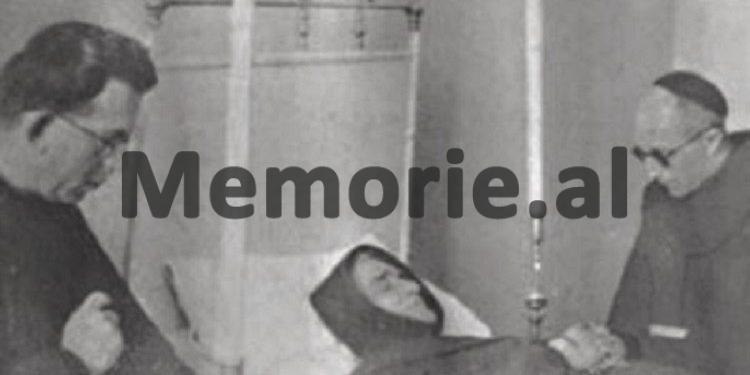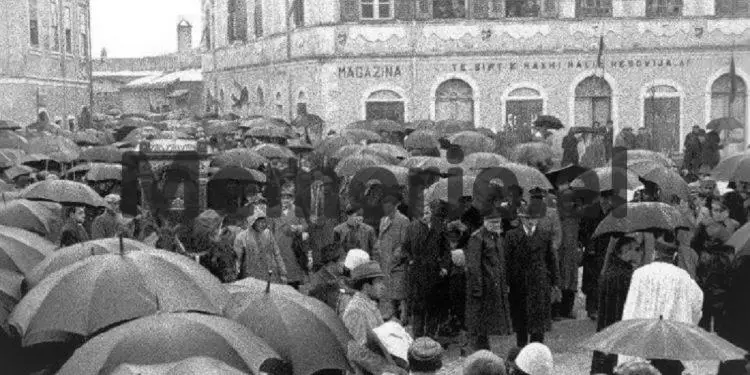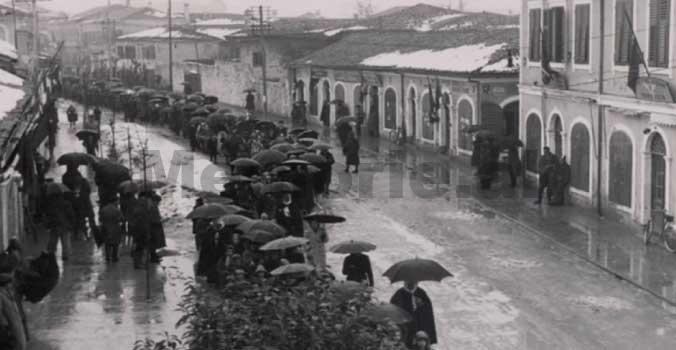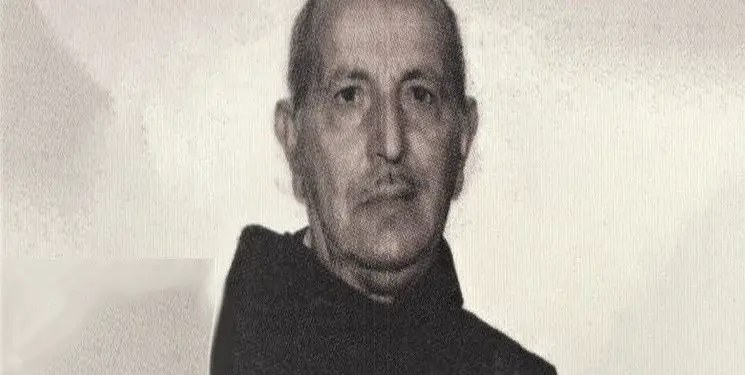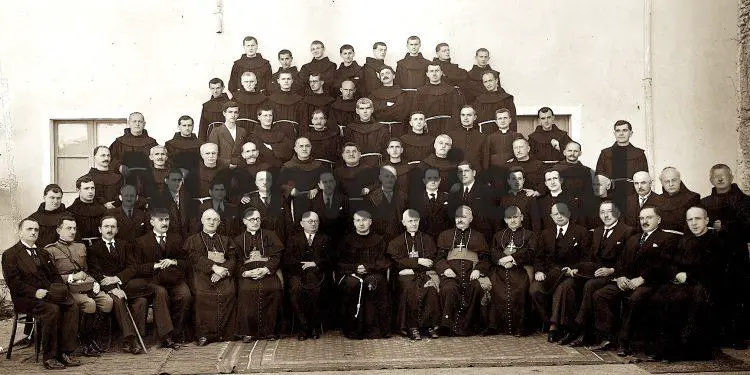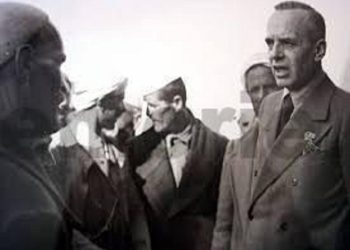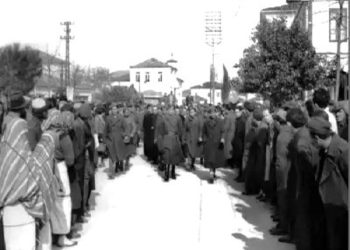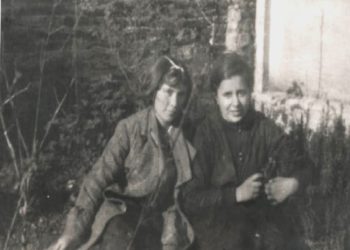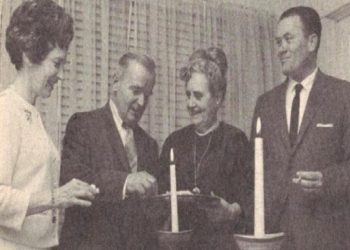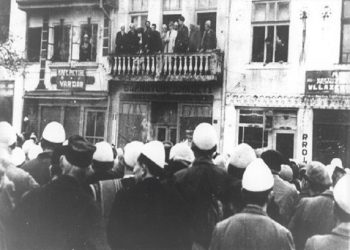By Irhan Jubica
The first part
A grave for the truth of Fishta’s bones.
Memorie.al / Question marks, too many question marks? Are the remains of Gjergj Fishta really thrown in Drin? Isn’t this story more of a legend, that because of the sensitivity of the public, turned out to be more functional than the literary one of 1963, with a general and a priest as protagonists? Is it possible that the same witness was present even when the grave was violated, which, according to a gravedigger, was about two meters away from the inscribed plaque, even when the bones were put in the bag, even when they were loaded into the cart and when the carriage has traveled along the city through a road of about 3 km. until Drin?! The Drin covers a good part of Shkodra, so where did they go to the Drin? On what date? At what time? Who else was a witness? Who were the gravediggers? What about the coachman? Did the gravediggers know what they were digging for? And the coachman, did he know what he was throwing into the river? Who ordered all these people? What if Fishta’s bones were not thrown into the river at all, but were hidden somewhere else?!
Why have none of the Franciscans who wrote the history of that famous Assembly answered these questions? Why hasn’t an official search for the rest of the bones been announced? Is it true that the war against faith in Albania was mostly a war against Catholicism (and Muslimism), guided or inspired by Slavic orthodoxy, perhaps due to an old jealousy of them towards Albanian Catholics, since the number of clerics Persecuted Orthodoxy is negligible, especially in relation to other faiths? These are not the only questions that arise when reading the few and fragmentary testimonies of those who lived at that time. This article tries to answer some of these questions, but of course the most essential question remains “Why?”.
Jerome again…!
“…Churches were destroyed…! Near the altars of Christ the horses were tied as in a manger…! The bones of the martyrs were taken out of the graves. According to Bogdan, the words of the Illyrian translator “St. Hieronim” of the Bible in Latin seem to have been written in 1967, and not somewhere around the year 400 of the first millennium, although they refer to the influx of Huns, Goths, Scythians and Vandals in the Balkans and beyond, best give the final picture of the Albanian communists’ war against faith.
This war had started in 1945, with the imprisonment, torture, internment, shooting of over 200 clerics, with the robbery and theft of the authorship of unique church archives, whose value, more than religious, was Albanian cultural and historical, with the demolition of 2300 buildings with architectural cult values. And precisely in 1967, exactly 1900 years after the crucifixion and burial of the apostle of Christ, St. Peter, in Albania, the remains of St. Fishta, the “Great Apostle of Albanianism”, as Koliqi calls him, were violated and dissolved. .
In fact, through the fault of the Albanians or not, the pantheon of the nation, which was never erected, lacks many of the bones of the great dead: the grave of Gjergj Kastriot was violated by the Turks, before the lifeless body of Pjeter Bogdan was thrown into the square. from Asians. (Zef Simoni writes that in 1946, after torture, even the hanging body of priest Mark Gjani was thrown to the dogs and the bones were released into the stream.)
Even the Serbs were not satisfied only with the murder of the convener of the “Canon”, Shtjefën Gjeçovi; “L’Osservatore Romano” of January 30, 2000 says that the communists also behaved in the same way with the remains of Jak Serreq, Lazër Mjeda, Gaspër Thaçi, Ernest Cozzi, Bernardin Shllakut and Gjergj Fishta. In many writings, Dede Gjo’ Luli is also mentioned, who is sometimes said to have been buried near Fishta, and sometimes in the small chapel, to the left of the altar of the Franciscan Church, together with the aforementioned friars, but this did not stop the communists they recognized him as a hero, even though they dissolved his bones.
The words of time, Fishta that is not!
February 7, 1967. The newspapers “Zëri i Populli”, “Bashkimi” and “Puna” publish the five-page speech, apparently against the bureaucracy, that Enver Hoxha had held the day before, at the extended meeting of several youth organizations of the Labor Party . A few days later, the speech is also published by “Voice of Youth”, “Jeta e re” and every local newspaper in the country. The journalist of the Central Committee of the ALP, Xhelil Gjoni, announces in the “ZP” of February 8, that; The high school students from Durrës of “Naim Frashër” have taken an initiative to free the country from the old and from religion. This main article, in the most feared newspaper in the country, is followed by other articles that reflect the enthusiasm of the youth for the “dacibaos” that also block the doors of churches and mosques.
Cultural Chineseness is supported in Durrës by the “Mujo Ulqinaku” school, and then by the whole country. In the long article; “The futility and harm of religious prejudice” of “ZP” on March 18, Selami Tabaku, Arif Gashi and Gjon Jaku (the latter accused by a contemporary, as one of the “first spies of the Security in Shkodër, the main informant for the Catholic part”), accuse Father Anton Harapin (who in 1944 wrote: “…for religion and homeland… this is the faith and this is the Albania that is disappearing from our hands”), Hafiz Ali Tarin (antizogist, Muslim theologian, who had a late speech, at Fishta’s funeral) of Sali Mufti for close ties with the invaders.
Fishta is everywhere, but nowhere is it mentioned. Fishta is not even mentioned in an article for the press in Shkodër, that Vehbi Bala, publishes in “Jeta e re”, where he managed to exclude the publicist Gjergj Fishta, from the fundamental contribution to the creation and direction of the “Elcia e saraze s Jezu” Christ”, “Zanit te Shna Ndout” and “Posta e Shqypnia”, but especially “Hylli te Drita”, without which there is no history of the Albanian press. It is the time when on the front pages of newspapers, through big headlines, the combined masses demanded; “to burn them”, “to destroy them”, not only the backward customs and the deceptions of religion.
A representative of the neighborhood “Kongresi i Përmet” in Shkodër, on March 19, wrote a letter to “comrade Enver Hoxha”, informing him that; The mosques they had in the neighborhood were being turned from slum centers into cultural institutions. Such actions were reported daily by radio and newspapers, such as in Gjepalaj, Durrës, Tirana, Roshnik of Berat, Kukës, etc. And in order to keep the fire where the enemies would burn, on April 16, the General Council of the Democratic Front of Albania addresses another call to the people; “to rise above the old”.
Together with countless leaflets, where in the name of youth the prohibition of religion was demanded, this was the visible side of what happened in 1967, the year that preceded official atheism, which culminated in the opening in Shkodër of the only atheist museum in world. The invisible part of this “iceberg” was fatal, because it passed through the offices of the State Security. E Sigurimi has not made any lightning sheet.
I said it or “do it”!
The story written for the first time in an “RD” of the beginning of 1991, apart from being copied from one newspaper to another, would circulate like those rumors, the truth of which, because they corresponded to the confirmed communist dictatorship as bloodthirsty and heartless , didn’t ask for concrete facts, but was content with an anonymous puff. Many of the authors who write about Fishta, since the beginning of democracy, are sure that; it happened exactly as he wrote in 1990, according to Zef Plum, an anonymous person in the hall of the Youth Club “Herojni e Vigu”:
By the order of Bilal Parruca, then chairman of the Executive Committee as well as chairman of the Democratic Front of Shkodra, Fishta’s remains were thrown into Drin. It seems, then, that this is the first contact that not only Zef Pllumi had with the news of Fishta’s exhumation, because in another article, Pllumi himself asked: “Was Fishta’s real grave ever discovered and were they thrown into the river, his bones? I can’t say for sure”.
This article on the resumption of “Hyllit te Drita”, Pllumi brings in 2001, in “Great Franciscans” and reconfirms it in 2006, in; “We never told the story”, but attaching a text where, among other things, it says: “This night. According to an eyewitness, the bones of the prisoners showed all their anger and threw them into Drin”. And then “…Mr. Ferdinand Topalli, who testified that he once saw Fishta’s bones in a cart with his eyes, to throw them in Drin” (“Histori negit e tregeme”, 2006).
Unlike Pllumi, who adds some elements to his writings, but without revealing the truth, Konrrad Gjolaj, also a Franciscan and a prisoner, in his brave work “Çinárt” (1996) mentions almost explicitly, “the rape graves of Fishta, Mjeda…”, while referring to the death of Bernardin Shllak, sheds light on the possible place of digestion of Fishta’s bones, when he says that; Shllaku was a burial place in the Franciscan Church, but “with the ‘cultural revolution’, His ashes were also dissolved by the Drinaza, near Bërdica, together with the ashes of other brothers of that Church”.
Bishop Zef Simoni, in the most quoted in the world; “Persecution of the Catholic Church in Albania, from 1944-1990” (published one year after “The Martyrdom of the Albanian Catholic Church, 1944-1990”, Tirana, 1993), lists Fishta in a list of names of Catholic priests who were the bones, without showing anything concrete about how, where, when and who committed these crimes! Meanwhile, with an absurd acrobatics, Dhori Qiriazi manages not to mention the violation of Fishta’s bones in his book; “Christianity in Albania” which probably should have had a lot of truth, about the persecution of the Catholic Clergy, especially their graves, as one of the most barbaric crimes committed by communism.
Even Kapllan Resuli in “Fishta and others” (2001) does not mention the exhumation of Fishta at all, despite the aim of his book. In 1992, while answering the accusations that had been made against Fishta for 50 years, the noble researcher, Injac Zamputi, apparently did not want to deal with the issue of bones. However, inside the covers of his book “Fishta. Time, man, work”, the publisher F. Ferra, takes for granted the violation of Fishta’s grave, when he writes;
“They didn’t manage to eradicate Fishta’s work, like they eradicated his bones”. Of course, the book with two dates “Gjergj Fishta. Life and work” by the author Vehbi Bala, could not have something about the mysterious exhumation of Fishta, not only because in the Albanian Encyclopedic Dictionary of 1985, this author had written “our blacks”, but also because the subject of the book it is dated February 1961, i.e. 6 years before the undated night of the grave violation.
Another author, M. Korça, in; “Patër Gjergj Fishta… genius without a grave”, although he does not provide any source, and does not quote any witness, he assures that “it was … a dark night in February, when the grave was raped. A pair of bones were thrown in Dri, to annihilate it! …They appointed Bilal Parruca to give the order”! It seems that many articles have been written in this spirit. F. Radovani, in “An underground monument”, is sure that; “besides the other Franciscans, the grave of the National Poet, Father Gjergj Fishta, was violated and… the tribes… were dissolved”.
Even one of the most serious researchers of Albanian literature, Anton N. Berisha, in his book; “The work of our being and being”, (Pristina 2003), does not feel it necessary to cite any source, when it claims: “The fury of the Kuznets towards this great creator [Fishta] and his work, reached the point of absurdity: ia they disappeared the grave and the bones”! Some current poems and sketches of democratic realism also take for granted the violation of Fishta’s grave, except with one heard.
At the end of 1996, two consecutive articles in “Rilindja Demokratike”, about Fishta’s reburial ceremony, apart from countless mistakes, offer nothing of the truth; even one of them can be considered irresponsible: after he called the bones several times; “dissolved waste. of the poet’s body”, A. Malja, writes on December 29, that the Franciscan church of Shkodra was destroyed during 1967 and “On this occasion, the remains of Father Gjergj Fishta were also lost”.
Just a day before, I. Seci, in the same newspaper, had mentioned several times that; Fishta’s bones were destroyed by communist barbarians, but without giving even the smallest detail, how this happened! It is also written there that; Fishta died on January 30; not December, because he died in 1910, not 1940, etc.; possible technical errors. But undoubtedly, the highest peak of what can be called manipulation with the issue, is a newly published book, authored by Pjetër Pepa. About 15, of the 1600 pages of the two-volume; “The tragedy and glory of the Catholic clergy in Albania” (2007), are dedicated to the chapter with the title; “March 20, 1967. The remains of the National Poet Father Gjergj Fishta are thrown into Drin”.
After announcing the news already in the title, the author seems to regret it in the following lines, when he writes: “To be accurate with history, I must say that I am not sure if, indeed, on this date, the bones were thrown in Drin of the National Poet”! And then: “They threw themselves into Drin e, everything ended in shame” (v. II, page 373). Although he does not question the throwing of the bones in Drin, the author does not consider it necessary to clarify to the readers, but also the story, with which he claims to be correct, how the act happened and who the actors were.
Where do you get it…?!
Perhaps no one wants to discuss the authenticity of the (f)act of digesting the bones of Gjergj Fishta, but after browsing thousands of pages, books and newspapers, it is impossible to resist the temptation to ask the next question: When? There is so little information in circulation, and the time for the opening of the secret archives, it seems, will never come in Albania, which is almost certain, that perhaps due to the nature of the case, even this simple, non-implicating question ; “When”? may never be answered. As long as both dates offered are not supported by evidence or documents, it would be wrong to believe, as the time of performing that hyena rite, either the night of February, claimed by M. Korça, or March 20 of refuted by P. Pepa himself!
Nominus svnt odiosa
It is a sin that Konrrad Gjolaj, this man drunk with the truth, has not written anything about the exhumation of Fishta, even if the impression is created that; this very subject constituted the chapter, which seems to have been removed at the last moment from his book “Chinars”, recently republished by the Franciscans; “with the permission of the head of religion”. However, the gap that other authors create in their works about Fishta, regarding the next question; “Who violated the grave”, can be completed by the extraordinary confession of the Velipojak friar Gjolaj, alias Tomë Marku.
One of the chapters of this book, not honored with any “Feather” by the MTKRS, and not even very popular in Shkodra and elsewhere, for the harsh truths, is the one dedicated to his teacher, one of the two German priests, shot in Shkodër in 1946: Alfons Trackit. Before this chapter, the countless poems and songs dedicated to teachers are small, but let’s get back to the point. Page after page, presenting the state of the Catholic Clergy, since 1945, Father Gjolaj, does not hesitate to give many names of those who were the protagonists of the attack on faith, an attack that did not stop with death.
The year 1967 is not that far away, so the presentation of the following names can bring back the memory of those who know something about this dark event. Always quoting Father Konrad Gjolaj, from his book “Çinarët” (1996), we find that: “Misto Treska, Kolë Jakova, Rasim Guri, Gjovalin Luka, Irakli Bozo, Tonin Jakova, Gjon Bushati, Muhamet Oruçi, Ahmet Daja, Sadetin Mandija, Ismail Barbullushi, Zija Dibra, Mark Ndoja, Arif Gjyli, Hajdar Delvina, Dulaç Lekiqi, Elez Mesi, Qazim Kapisyzi, Zoj Themeli, Fadil Kapisyzi, Hysni Ndoja, Dul Rrjolli, Lilo Zeneli, Zoj Skurti, Nesti Kopali, Gjon Prendushi, Česk Shoshi, Hys Zaja, Pjetër Darragjati, Mestan Ujaniku, Aranit Çela, Tonin Miloti, Spiro Pano, Gjon Jaku, Rrahman Përllaku, Qamil Gavoçi, Gani Dizdari, Ahmet Çaku, Mahmut Kaja, Shaban Arra, Gaspër Leci, Martin Margilaj, Gac Mazi . Hasi, Mark Uli, Sadik Rama, Rustem Sykja, Nevzat Haznedari, Ndoc Deda, Vehibe Xhabija, Djixhi Mazi, Xhuhere Mushani, Satber Jubani, Minire Haxhi, Kasem Troshani, Xheudet Miloti, Hamdi Ulqinaku, Shyqiri Çoku, Asllan Lici, Rakip Beqja, Jup Kastrati, Viron Koka, Bik Pepa, Kadrie Kopliku, Marie Vasili, Mita Leka, Bose Marku, Marie Siliqi, Laje Haxhia, Gjylafe Gjylbegu, Jovanka Perja, Violeta Stavri, Adlije Kazazi, Pal Mëlyshi, Xhemal Selimi, Adlije Bushati, Ndreko Rino . Hebovija, Loro Beltoja, Xhemal Dini, Angjelin Kumria, Fadil Ymeri, Ramiz Hafizi, Halit Isufi, Fadil Kraja, Jovan Vojushi, Selahedin Cena, Luigj Frangaj, Mikel Prennushi, Musa Kraja, Lin Simoni, Pjetër Hasi and Mark Tarri, were the most active at the time at the forefront of the war against religion and religious people.
He also mentions Ndoc Vasili, the young deacon, who later, according to him, would become an accomplice of the Security in introducing weapons into the Church, as well as several other priests, who later repented and were forgiven by the superiors of the church . According to Gjolaj, the duties and benefits of each were separate: some were spies; some agitators and shouters in courtrooms against the clergy; a part acquired scientific works from church archives and received their doctorate, with the studies of Justin Rrota, for example; some were unfaithful to friends; some have stained their hands with blood, torturing to death, mutilating legs, driving nails into skulls, or executing innocents; some undertook investigations, filed charges and signed death warrants; a part were commoners, thieves, criminals, rapists; a piece…! Memorie.al
The next issue follows





